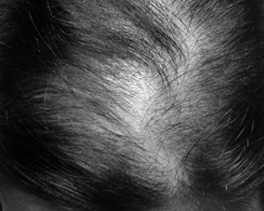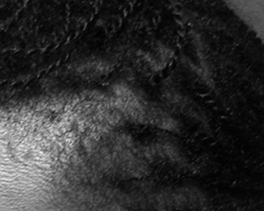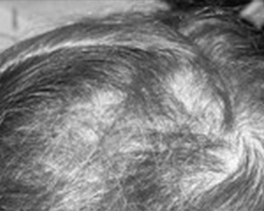Types of Hair Loss
Genetic Hair Loss (Androgenetic Alopecia/Female and Male), Telogen Effluvium, Alopecia Areata/Totalis/Universalis, Trichotillomania, Traction Alopecia and Cicatricial Alopecia.
The different types of hair loss and hair growth disorders can often be difficult to distinguish for a sufferer and sometimes even for a healthcare or industry professional (doctor, pharmacist, hair professional or other).
Common Types of Hair Loss

In women, the prevalence of FPHL affects over 30% of the population. Its presentation is characterised by a diffuse thinning over the entire scalp, primarily evident with the widening of partings. It typically influences both the frontal and vertex (crown) regions, occasionally forming a pattern resembling a ‘Christmas Tree’. A denser band of hair is often retained along the frontal hairline, with a noticeable thinning as one observes the areas closer to the crown.
For men, MPHL manifests distinctively with the hair follicles located at the temples, hairline, and crown being highly sensitive to a hormone called dihydrotestosterone (DHT). DHT disrupts the natural Hair Growth Cycle, causing the growth phase (Anagen) to shorten progressively over time. This means hair strands do not attain their previous lengths and, with each hair having a set number of growth cycles (usually 8-10), they exhaust these cycles more rapidly. Over time, the hair follicles influenced by DHT undergo miniaturisation, leading to the production of finer, less pigmented hairs. Ultimately, these follicles only yield very fine, nearly transparent “peach fuzz” hairs before ceasing hair production altogether.
At the core of Androgenetic Alopecia is the condition termed Proteoglycan Follicular Atrophy, leading to the diminishment of affected follicles’ size. Consequently, the hairs produced by these follicles are finer in diameter, a hallmark feature of this hair loss type.
Various triggers, such as stress, health conditions, and significant hormonal changes linked to events like childbirth or menopause, can exacerbate this condition in women. In society, hair loss in women is generally perceived with greater stigma than in men, which can amplify the psychological effects on sufferers.
While there are treatments available for Androgenetic Alopecia, some medications may come with side effects, and many offer only minimal results. Hair transplants, though effective for some, are invasive and often considered a last resort. Alternative approaches aim to naturally address the disruption in the Hair Growth Cycle, restoring a balance between the growth and resting phases.

The condition can present in two forms:
Acute Telogen Effluvium: Triggered by factors like stress, hormonal changes, or illness, this form surfaces 4-16 weeks post the inciting event and is recognized by increased hair shedding, known as acute TE.
Chronic Telogen Effluvium: This variant unfolds more gradually and persists longer, resulting in consistent shedding and increased dormancy of hair follicles over time. This is sometimes referred to as chronic TE.
The onset of TE might not be immediately evident beyond finding more hair in your brush or during washes. The loss is generally even across the scalp, but some regions might exhibit more noticeable thinning. A significant number of women encounter TE post-childbirth due to hormonal fluctuations, with up to 40-50% of new mothers facing postpartum hair loss, also termed Postpartum Effluvium. This is attributed to the delayed Telogen phase during pregnancy that later results in simultaneous hair release 2-4 months post-delivery, continuing for about 6 weeks to 15 months.
At the root of this condition is the disturbance to the Hair Growth Cycle, known as Proteoglycan Follicular Atrophy. This causes the growth phase (Anagen) hairs to prematurely shift to the resting phase (Telogen).
It’s crucial to address even the initial symptoms of hair loss with a Proteoglycan Replacement Therapy. By utilising such treatments early on, especially postpartum, you can support your hair in maintaining its quality, appearance, and natural growth cycle before the situation aggravates.

In rare instances, Alopecia Areata can escalate to affect the entire scalp, leading to what’s called Alopecia Totalis. An even less frequent manifestation is Alopecia Universalis, where the condition impacts the entirety of the body, resulting in a comprehensive loss of scalp, facial, and body hair.
This condition predominantly surfaces in younger individuals, especially those under the age of 30. However, it’s crucial to note that Alopecia Areata can emerge at any age and is known to influence both genders equally.
The onset of Alopecia Areata is typically rapid. However, there’s a silver lining: the condition has an inherent tendency to reverse on its own, particularly if the Hair Growth Cycle is balanced. A critical factor in this balance is the presence of proteoglycans. With the progression of the condition, there can be a decline in these essential molecules. Replenishing the lost proteoglycans is pivotal in normalising the Hair Growth Cycle, ensuring it functions optimally, and potentially aiding in the restoration of healthy hair growth.
It’s imperative for anyone detecting the initial signs of this hair loss to consider approaches that focus on restoring the balance of proteoglycans. Such interventions can lay a foundational treatment pathway to counteract the effects of Alopecia Areata and its more severe forms.

Maintaining an optimal Hair Growth Cycle is paramount to fostering new and healthy hair growth. Given the myriad of external factors that can contribute to hair damage and stress, it’s crucial to be proactive in hair care. Using the right products and limiting the use of heating and styling tools can go a long way in mitigating the risks.
For those already noticing the initial signs of hair weakening or loss, interventions that focus on restoring the balance of proteoglycans are recommended. These molecules play an instrumental role in normalising the Hair Growth Cycle. Adopting treatments that replenish proteoglycans can help in countering the effects of Traction Alopecia and restoring the natural vibrancy and strength of the hair.

While stress or depression can trigger Trichotillomania, the act of pulling can become an uncontrolled impulse for some, making it hard to deter even with conscious efforts. The condition has a more frequent occurrence in women, being twice as common in females compared to males. Intriguingly, it’s also more prevalent among children than adults.
For those affected, the condition isn’t just about physical hair loss. The lack of understanding and societal stigma associated with Trichotillomania can lead to feelings of shame and isolation. Consequently, there’s a significant need to raise awareness, provide support, and cultivate understanding for those grappling with the condition, to elevate their quality of life.
Once the pulling impulses are managed and controlled, attention must be focused on supporting the Hair Growth Cycle to foster the emergence of new, healthy hair.
Addressing and normalising the Hair Growth Cycle’s disruption is crucial for the restoration and maintenance of hair health. Proteoglycan Replacement Therapy is an effective and immediate and baseline treatment.

The manifestations of Cicatricial Alopecia can vary, with the skin often presenting a scarred, translucent, or de-pigmented appearance. The pattern of hair loss can be patchy or diffuse, further complicating the condition.
Given the impact on the Hair Growth Cycle, it’s of paramount importance for individuals experiencing any onset of such hair loss symptoms to consider therapeutic interventions. One such approach is Proteoglycan Replacement Therapy, which aims to restore the balance of proteoglycans. By doing so, this therapy works to normalise the Hair Growth Cycle, thereby promoting the regeneration of healthy hair growth.
Hair Loss Facts
There are many different types and causes of hair loss. However, the specific types and causes related to your individual situation are often difficult to pinpoint without professional counsel.
It is important to always be aware that no matter the hair loss cause or type, the Hair Growth Cycle is always negatively affected and often an underlying Proteoglycan Follicular Atrophy can be present.
Therefore, knowledge about normalising the Hair Growth Cycle, Proteoglycan Follicular Atrophy and ultimately Proteoglycan Replacement Therapy is vital for a successful outcome of any treatment approach.
Read more